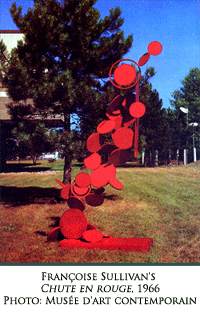 | ||||||||
| ||||||||
 | ||
The boundaries between visual art, dance and even theatre all but disappeared in her conceptual art pieces of the 1970s and 1980s as Sullivan explored the potential fluidity between artistic disciplines. Most notably, in 1970, Sullivan created Walk from the Musée d'art contemporain to the Montreal Museum of Fine Arts and back a series of photographs that documented a walk she took from the Museum of Contemporary Art to the Montréal Museum of Fine Arts and then back again on a sunny day, recording the sights along the way. While movement in this series is suggested by the curve of the roads, the blur of a car travelling through an intersection and the bended knee of a pedestrian caught in mid-stride as he appears to leave the frame of a photograph, it is the unrecorded images between each photograph that convey the most movement; it is in these "absences" that Sullivan lowered her camera and continued to walk. Thus, although the very definition of a photograph is the "fixing of time", Walk from the Musée d'art contemporain to the Montreal Museum of Fine Arts and back complicates this notion by transmitting the energy of movement that was required to create the work. In a very real sense Walk from the Musée d'art contemporain to the Montreal Museum of Fine Arts and back choreographed viewers' visual experience. The artwork was anchored with a photograph of the Museum of Contemporary Art in the top left-hand corner and a photograph of the Montréal Museum of Fine Arts in the bottom right-hand corner. In the middle of this mirroring design was an empty black space the size of two of the photographs as if suggesting there were a black hole - perhaps ideologically or historically - between these two important Montréal institutions. Whatever, the semiotic possibilities created by the layout of the photographs, viewers were being asked to read the images in a particular order. Other works by Sullivan not only choreographed the flow of the viewers' visual experience, but also directed their spatial orientation and movements. In her 1972 Travaux d'Italie, visitors could not actually enter the gallery. Instead, there were messages for them to read on the outer wall and they could peer through holes at objects Sullivan had collected and displayed, including spaghetti sauce and Roman soil, among other local objects. Sullivan combined photography and movement in other visual arts projects in the late 1970s. Oya - Intervention at Oya, Island of Santorini (Greece) photographed by David Moore, and Abandoned Window, Blocked and Unblocked - Intervention on Blasket Island, Ireland, both created in 1978, documented Sullivan - sometimes included in the photograph, sometimes not - piling and/or removing rocks from old, weathered window frames. Shadow - Intervention in Delphi (Greece) was a series of photographs of Sullivan taken at an amphitheatre during a trip to Greece. In the first photograph of the Shadow series, Sullivan looked like a sundial measuring time with her shadow, but in the successive images she corkscrewed down and around herself until in the last picture she was prone on the ground as if on top of her shadow. Time could no longer be gauged; it was temporarily halted by Sullivan's displacement of her shadow and, in the resulting photograph, forever suspended by the camera shutter. During the late 1970s and into the early 1980s, Sullivan created her Accumulation series. This project involved dancers and ordinary objects in different locations in Canada as well as internationally. In Accumulation III, for instance, dancers transported a pile of stones from the door of a museum to an open space to construct a circle. The work was loosely choreographed and incorporated repeated pedestrian or everyday movements alongside improvised moments. By placing non-theatrical activities within a performance context, Sullivan invited spectators to explore the ritual elements contained within mundane and repetitive movement sequences. In the 1970s, Sullivan began to choreograph dance for the stage again. The first work she created after such a long hiatus was Droit debout, which premiered in 1973 featuring the dancers of Le Groupe de la Place Royale, the company created by Sullivan's friend and former collaborator, Jeanne Renaud, which was then under the joint artistic leadership of Peter Boneham and Jean-Pierre Perreault. Droit debout (Standing Straight) subtly asserted Sullivan's interdisciplinary position as both a choreographer and a sculptor. The work consisted of the dancers standing on stage in stillness like statutes for thirty minutes, accompanied only by the sound of Sullivan's voice as she recited a poem, also entitled Standing Straight, lyrically and verbally tracing the body: "The bareness of the forehead"; "The line of the eyebrows"; "the contours and delicateness / of the ears ..." Sullivan's voice-over was a tour guide to the dancers corporeality. (next page) ©2006, Dance Collection Danse | ||

